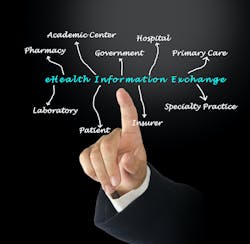Health information network eHealth Exchange has developed an incentive program to help health systems with the technology and labor costs involved with adopting Networked FHIR, which offers a single connection to multiple network participants and to enable a single user workflow.
The organization said it would waive its one-year annual fee for the first 15 non-federal healthcare providers or health information exchanges (HIEs) that successfully exchange electronic patient data with healthcare payers based on specifications outlined in the HL7 Da Vinci Project Implementation Guides.
The Da Vinci Project initiative comprised of industry leaders and health information technology technical experts who are working together to accelerate the adoption of the FHIR standard to support and integrate value-based care data exchange across communities.
In addition, eHealth Exchange said it would waive annual fees for the first three healthcare payers who successfully exchange patient data with non-federal healthcare providers or HIEs within eHealth Exchange according to defined dates and using the Da Vinci specifications.
The incentive plan will include additional implementation support and recognition as the industry moves to adopt these new standards.
A Qualified Health Information Network (QHIN) candidate under the Trusted Exchange Framework and Common Agreement (TEFCA), eHealth Exchange is introducing the stimulus to accelerate the transition from data exchange using fax, web portals, and proprietary interfaces.
In 2022, eHealth Exchange successfully deployed FHIR R4 nationwide for next-generation electronic exchange of rich clinical patient data involving validation of adverse events between healthcare providers and the U.S. Food and Drug Administration. The first-of-its-kind, large-scale Networked FHIR implementation validated FHIR R4 can be successfully deployed nationwide to help not only healthcare providers, but also public health agencies. This previous incentive program established how FHIR can be deployed at scale when a trusted intermediary, such as eHealth Exchange, is positioned to support and simplify the adoption of the new FHIR standards.
“The market needs a single workflow for payers and public health agencies to interact with providers and HIEs,” said Jay Nakashima, eHealth Exchange’s executive director, in a statement. “A move to adopt HL7 Da Vinci guides and FHIR as a primary standard for exchange aligns extremely well with eHealth Exchange’s mission and our history of adopting standards-based methods to scale connectivity and interoperability in healthcare nationwide.”
The nonprofit eHealth Exchange facilitates roughly 20 billion data exchanges annually, providing connectivity for 60 regional and state HIEs, 75 percent of U.S. hospitals, 85 percent of dialysis centers, and 70,000 medical groups – as well as countless urgent care centers, surgery centers, and clinical laboratories. The bulk of that activity relates to medical treatment.
However, there are myriad workflows associated with payment, prior authorization, and medical review. FHIR and the Da Vinci Implementation Guides solve some of those challenges by standardizing workflows, simplifying the information exchange process, reducing administrative burdens, and increasing value-based care opportunities.
Recognizing the potential of FHIR, ONC has released a FHIR Roadmap to be incorporated into TEFCA in the future.
“If we don’t come together, we will end up with a variety of disconnected solutions and workflows for payers and public health agencies. And that’s not tenable,” said Nakashima. “We have an eye on the TEFCA FHIR Roadmap and believe there is a lot we can do in advance of that timeline. We want to take an open and collaborative approach to solving payer and health exchange challenges.”


